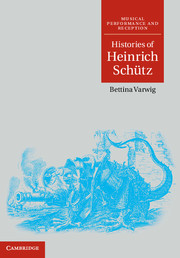Book contents
- Frontmatter
- Contents
- Abbreviations
- Music examples
- Figures
- Acknowledgments
- Introduction
- Chapter One Trumpets and drums (Psalmen Davids, 1617)
- Chapter Two Echoes, mirrors and masks (Dafne, 1627)
- Chapter Three Life, death and afterlife (Musicalische Exequien, 1636)
- Chapter Four Old and new worlds (Geistliche Chor-Music, 1648)
- Conclusion
- Chronology
- Bibliography
- Index
Chapter Three - Life, death and afterlife (Musicalische Exequien, 1636)
Published online by Cambridge University Press: 05 November 2011
- Frontmatter
- Contents
- Abbreviations
- Music examples
- Figures
- Acknowledgments
- Introduction
- Chapter One Trumpets and drums (Psalmen Davids, 1617)
- Chapter Two Echoes, mirrors and masks (Dafne, 1627)
- Chapter Three Life, death and afterlife (Musicalische Exequien, 1636)
- Chapter Four Old and new worlds (Geistliche Chor-Music, 1648)
- Conclusion
- Chronology
- Bibliography
- Index
Summary
1. It is to be noted that this concerted motet is for two choirs, each choir singing its own words. Chorus primus is in five parts and recites the words of Simeon: Herr, nun lässestu deinen Diener. Chorus secundus is in three parts, for two trebles and a baritone or high bass, singing the following words and others: Selig seynd die Todten, die in dem Herrn sterben. With this invention or choro secundo the author has attempted to intimate and suggest in some way the joy of the blessed disembodied soul in Heaven in the company of heavenly spirits and holy angels. 2. Primus chorus is to be placed in close proximity to the organ, but secundus chorus is to be set up at a distance, according to what seems most practicable.
Schütz's much-quoted instructions regarding the third and final part of his Musicalische Exequien offer an unusually vivid account of the musical sounds he envisaged. Similarly informative remarks accompany the first section of the work as well. The story of the piece's provenance – told many times before – is both picturesque and historically detailed: sometime in the year before his death on 3 December 1635, Herr Heinrich Posthumus Reuss secretly had his coffin assembled, decorated with a series of biblical quotations and chorale verses on the topic of death. Schütz, who had been born into Reuss's territory and later encountered him on several occasions, was then commissioned to compose the Exequien for Reuss's funeral service at the Johanniskirche in Gera on 4 February 1636. Part I (SWV 279), entitled ‘Konzert in Form einer teutschen Begräbniß-Missa’, sets the words engraved on the coffin as a paraphrased ‘German funeral mass’, with an embellished ‘Kyrie’ plus ‘Gloria’ structure. The shorter second part (SWV 280) comprises a double-choir motet on the biblical passage used in the central funeral sermon (‘Herr, wenn ich nur dich habe’, Psalm 73), while Part III (SWV 281) presents two further scriptural texts in the manner described in the prefatory ‘Ordinantz’ just cited.
- Type
- Chapter
- Information
- Histories of Heinrich Schütz , pp. 109 - 160Publisher: Cambridge University PressPrint publication year: 2011

